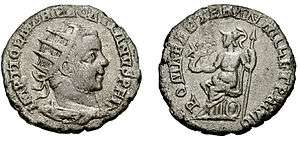Ab urbe condita
Ab urbe condita (Latin: [ab ˈʊrbɛ ˈkɔndɪtaː]; 'from the founding of the City'), or Anno urbis conditae (Latin: [ˈan.no̯‿ʊrbɪs ˈkɔndɪtae̯]; 'in the year since the City's founding'),[note 1] often abbreviated as AUC, is an expression used in antiquity and by classical historians to refer to a given year in Ancient Rome. In reference to the traditional year of the foundation of Rome, 753 BC would be written AUC 1, whereas AD 1 would be AUC 754. The foundation of the Empire in 27 BC would be AUC 727.

Usage of the term was more common during the Renaissance, when editors sometimes added AUC to Roman manuscripts they published, giving the false impression that the convention was commonly used in antiquity. In reality, the dominant method of identifying years in Roman times was to name the two consuls who held office that year. In late antiquity, regnal years were also in use, as in Roman Egypt during the Diocletian era after AD 293, and in the Byzantine Empire from AD 537, following a decree by Justinian.
Significance
The traditional date for the founding of Rome, 21 April 753 BC, is due to Marcus Terentius Varro (1st century BC). Varro may have used the consular list (with its mistakes) and called the year of the first consuls "ab urbe condita 245," accepting the 244-year interval from Dionysius of Halicarnassus for the kings after the foundation of Rome. The correctness of this calculation has not been confirmed, but it is still used worldwide.
From the time of Claudius (fl. AD 41 to AD 54) onward, this calculation superseded other contemporary calculations. Celebrating the anniversary of the city became part of imperial propaganda. Claudius was the first to hold magnificent celebrations in honor of the anniversary of the city, in AD 48, the eight hundredth year from the founding of the city. Hadrian, in AD 121, and Antoninus Pius, in AD 147 and AD 148, held similar celebrations respectively.
In AD 248, Philip the Arab celebrated Rome's first millennium, together with Ludi saeculares for Rome's alleged tenth saeculum. Coins from his reign commemorate the celebrations. A coin by a contender for the imperial throne, Pacatianus, explicitly states "[y]ear one thousand and first," which is an indication that the citizens of the empire had a sense of the beginning of a new era, a Sæculum Novum.
Calendar era
The Anno Domini (AD) year numbering was developed by a monk named Dionysius Exiguus in Rome in AD 525, as a result of his work on calculating the date of Easter. Dionysius did not use the AUC convention, but instead based his calculations on the Diocletian era. This convention had been in use since AD 293, the year of the tetrarchy, as it became impractical to use regnal years of the current emperor.[1] In his Easter table, the year AD 532 was equated with the 248th regnal year of Diocletian. The table counted the years starting from the presumed birth of Christ, rather than the accession of the emperor Diocletian on 20 November AD 284 or, as stated by Dionysius: "sed magis elegimus ab incarnatione Domini nostri Jesu Christi annorum tempora praenotare" ("but rather we choose to name the times of the years from the incarnation of our Lord Jesus Christ").[2] Blackburn and Holford-Strevens review interpretations of Dionysius which place the Incarnation in 2 BC, 1 BC, or AD 1.[3]
The year AD 1 corresponds to AUC 754, based on the epoch of Varro. Thus:
- AUC 1 = 753 BC (Foundation of the Kingdom of Rome)
- AUC 244 = 510 BC (Overthrow of the Roman monarchy)
- AUC 727 = 27 BC (Augustus became the first Roman Emperor, starting the Principate)
- AUC 753 = 1 BC
- AUC 754 = AD 1
- AUC 1000 = AD 247
- AUC 1037 = AD 284 (Diocletian became Roman Emperor, starting the Dominate)
- AUC 1229 = AD 476 (Fall of the Western Roman Empire by the armies of Odoacer)
- AUC 1246 = AD 493 (Establishment of the Ostrogothic Kingdom)
- AUC 1306 = AD 553 (Italy under Eastern Roman control)
- AUC 1507 = AD 754 (foundation of the Papal States)
- AUC 1930 = AD 1177 (Papal States became independent from the Holy Roman Empire)
- AUC 2000 = AD 1247
- AUC 2206 = AD 1453 (Fall of Constantinople)
- AUC 2542 = AD 1789 (French Revolution)
- AUC 2623 = AD 1870 (Foundation of the Kingdom of Italy)
- AUC 2699 = AD 1946 (Proclamation of the Italian Republic)
- AUC 2753 = AD 2000
- AUC 2773 = AD 2020
- AUC 2774 = AD 2021
See also
- List of Latin phrases – Wikimedia list article
Notes
- In literal grammar translation, ab urbe condita becomes English "from the founded city", and anno urbis conditae becomes "in the year of the founded city". While this produces odd-sounding English syntax, in Latin this manner of expression is valid, and in particular usual for the word condo ("to found", etc.) in the Classical language; it conveys a tone that is somewhat more archaic and lofty.
Citations
- Thomas, J. David. 1971. "On Dating by Regnal Years of Diocletian, Maximian and the Caesars." Chronique d'Égypte 46(91):173–79. doi:10.1484/J.CDE.2.308234.
- Migne, Jacques-Paul. 1865. Liber de Paschate (Patrologia Latina 67), p. 481, § XX, note f
- Blackburn, B. & Holford-Strevens, L, The Oxford Companion to the Year (Oxford University Press, 2003 corrected reprinting, originally 1999), pp. 778–780.
External links
